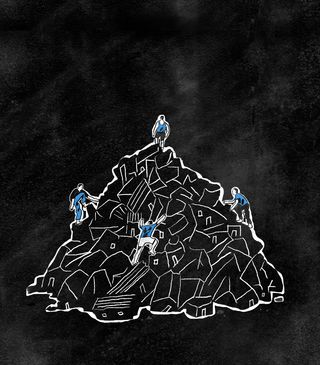
Dispatches From Jai Bhim Nagar
Jai Bhim Nagar was a settlement near Mumbai’s posh Hiranandani area. It housed nearly 700 families, many of whom came to the city to built its dazzling cityscapes. On 6th June, it was razed to the ground.
The demolition of Jai Bhim Nagar, Mumbai, raises existential questions about India. Who has the right to its cities? Is it those who live in them, or those who build them? In this illustrated report, Rushikesh Gawade and Hitesh Sonar bring dispatches from the settlement as its displaced residents mobilize, rebuild, and symbolically reclaim their citizenship against impossible odds.
The Demolition


Residents allege that along with the team of BMC officials and the Mumbai police, the demolition party also comprised some private “bouncers” representing a builder. They accused the group of brutally beating them up, even women and children. The police, on the other hand, have alleged that the residents pelted stones at the demolition party.


.png?w=320&h=320&auto=format)
The Aftermath
.png?w=320&h=320&auto=format)
.png?w=320&h=320&auto=format)
Two of them were in their early twenties. The other two were younger. The book was a Marathi translation of the Indian Constitution. Behind them lay their houses, most of them only made of sheet metal, now ravaged by bulldozers. They had not been given a chance to take their belongings when the demolition happened.
.png?w=320&h=320&auto=format)
.png?w=320&h=320&auto=format)
All of them grew up in Jai Bhim Nagar, they told me. Two of them work as housekeeping staff in the Hiranandani area's various residential buildings. One of them recently finished school and had plans to apply for an ITI (Industrial Training Institute) vocational course. But after losing his house during the demolition, he wasn't sure how he'd be able to proceed.
They said their families migrated to the city decades ago. I asked them if they're considering going back to their villages now. “There is nothing for us in the village. Our jobs are here,” one replied. None of them have any land to their name -- neither here, nor in their villages. Staying here is precarious, but going back is not an option.
That same evening, the newly re-elected Prime Minister of the country was sworn in, as were other political leaders over the next few days. All of them took their oaths on The Constitution.
.png?w=320&h=320&auto=format)
The Footpath
I visited Jai Bhim Nagar again, 13 days after the demolition. There’s a stronger metal sheet around the demolished site.
.png?w=320&h=320&auto=format)
.png?w=320&h=320&auto=format)
The injured are still nursing their wounds, and some are waiting for their loved ones to be released from detention. There are children wandering about, clueless, clutching a few donated stationery kits. A few organizations are helping with food and water, while a local politician arranged for some portable toilets.
Some political leaders and civil society groups condemned the demolition and called it illegal. They're demanding relief for the residents. As for the residents themselves, they’re trying hard to survive life on the footpath.
.png?w=320&h=320&auto=format)
.png?w=320&h=320&auto=format)
.png?w=320&h=320&auto=format)
The residents told me they're resolved to get justice -- and won’t leave the footpath until they do.
.png?w=320&h=320&auto=format)
The Resettlement
I have often walked the very footpath where Jai Bhim Nagar’s residents have currently taken refuge after the demolition. Opposite the footpath, the luxe Hiranandani buildings tower over the city, impossibly elegant. They are still intimidating to me.


While their own homes were made of just blue tarpaulin and metal sheets.

.png?w=320&h=320&auto=format)

.png?w=320&h=320&auto=format)
The Survivors
It's been 19 days since the demolition.


One resident recalls how five police personnel beat up a pregnant woman because she tried to protect her husband, who was eating lunch, caught unaware by the demolition.


.png?w=320&h=320&auto=format)

Whether the settlement will manage to heal and live on, or finally give up and die, only time can tell. But whatever they do and wherever they go, she says, their existence will never be “legitimate.”
.png?w=320&h=320&auto=format)
The Constitution


Most slum dwellers are “informal” sector workers, contributing a lion's share of the city’s infrastructure. Many of them belong to landless marginalized social groups.
The millions of workers in Mumbai play an essential role in its survival. But the monstrous organism called the city keeps imposing more violence on the poor -- deligitimizing their existence, pushing their survival into greater precarity.
When a city like this deems their labor legitimate but not their existence, it is The Constitution which offers hope, they say. It allows them to transcend the binary of legal and illegal -- legitimizing their existence, rights, and equal citizenship.
The preamble of The Constitution of India secures the following for all citizens:





And as one resident of Jai Bhim Nagar puts it: "The Constitution is for all. It's not just for the people in the tall buildings. We too have a right to live our lives. Babasaheb's Constitution has given it to us."
.png?w=320&h=320&auto=format)
Rushikesh Gawade is pursuing his PhD in Sociology in the Humanities and Social Sciences Department of IIT Bombay, Powai, Mumbai. He can be found on instagram @rushikesh_0203 or on X @eyerushikesh.